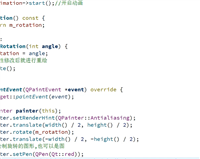为什么要实现运算符重载?
在 c++ 中,运算符最初是为内置类型(如int、double等)定义操作方式。当定义一个新的类(自定义类型)时,编译器并不清楚如何对这个新类型的成员变量应用运算符。
通过运算符重载,程序员可以明确地告诉编译器对于该类的对象,运算符(如+、-、*等)应该如何操作其成员变量,从而使自定义类型能够像内置类型一样自然地使用这些运算符。
1.加法运算符重载
作用:实现两个自定义类型数据的加法运算
在类内实现加法运算符重载
#include <iostream>
using namespace std;
class person {
int age;
int money;
public:
person() : money(0), age(0) {}
person(int val, int val2) : age(val), money(val2) {}
person(const person& other) {
this->age = other.age;
this->money = other.money;
}
// 类内实现+重载 本质:person p3=p1.operator+(p2)
person operator+(const person& other) {
person p;
p.age = this->age + other.age;
p.money = this->money + other.money;
return p; // 不以引用返回是因为,在执行完这个函数后,p会被销毁,以值传递会调用拷贝构造
}
void print() { cout << age << " " << money << endl; }
};
int main() {
person a(18, 50); // 括号法
person b = {12, 50}; // 隐式转换法
person c = a + b;
c.print();
return 0;
}实现加法运算符重载的operator+函数来完成的,传入的参数为const person& other的原因有以下的两点:
- 1.以引用的方式传递是为了防止调用拷贝构造
- 2.加const修饰是为了防止修改实参
在函数中声明了一个person的对象p,返回值是以值的形式返回,因为值返回会调用拷贝构造,如果是以引用的方式传递,当这个函数结束时,对象p就会被销毁掉。
在类外实现加法运算符重载
#include <iostream>
using namespace std;
class person {
int age;
int money;
friend person operator+(const person& other1, const person& other2);
public:
person() : money(0), age(0) {}
person(int val, int val2) : age(val), money(val2) {}
person(const person& other) {
this->age = other.age;
this->money = other.money;
}
void print() { cout << age << " " << money << endl; }
};
// 类外实现+重载 本质:person p3=operator+(p1,p2)
person operator+(const person& other1, const person& other2) {
person p;
p.age = other1.age + other2.age;
p.money = other1.money + other2.money;
return p;
}
int main() {
person a(18, 50); // 括号法
person b = {12, 50}; // 隐式转换法
person c = a + b;
c.print();
return 0;
}在类外实现加法运算符重载,相当于类外函数访问类内的成员变量,所以要将这个函数在类中声明为友元函数(friend)。其他的跟在类内实现加法运算符重载是一样的。
本质:在类内实现加法运算符重载的本质是:person p3=p1.operator(p2)
在类外实现加法运算符重载的本质是:person p3=operator+(p1,p2)
因为一个是通过对象去调用这个函数,它本身也算是一个参数,所以只需要传人一个参数。而在类外,则是相当于直接调用这个函数,所以传入的参数是两个。
无论是再类内还是在类外实现加法运算符重载,最后调用的方式都是+。
2.左移运算符重载
作用:可以输出自定义数据类型
要在类外实现,因为在类内的话,调用格式为:对象.operator();无法达到cout<<
#include <iostream>
using namespace std;
class person {
int age;
int money;
public:
friend ostream& operator<<(ostream& o, const person& p);
person() : age(0), money(0) {}
person(int val, int val2) : age(val), money(val2) {}
person(const person& other) {
cout << "调用拷贝构造";
this->age = other.age;
this->money = other.money;
}
// 一般不在函数内进行左移重载
/*void operator<<(ostream& cout,const person p) {
}*/
};
// 类外实现左移运算符重载
ostream& operator<<(ostream& o, const person& p) {
o << p.age << " " << p.money << endl;
return o;
}
int main() {
person a(5, 12), b;
cout << a << b << endl;
return 0;
}因为是在类外实现的,所以在类内要将其设置为友元函数。参数为两个,一个为ostream类型的o,另外一个为引用类型的对象。
返回值为引用类型的ostream类型的ostream,因为如果想要进行连续的输出,就必须让前一个的结果作为第二个左移运算符的第一个参数,如下图:

在o<<p.age的返回值为o,然后它与后面就变成了o<<" ",接着又调用这个运算符,这样才能完成连续的输出。
3.递增运算符重载
递增分为两种一种是前++,一种是后++。前++是在使用之前就让这个数加1,返回的是加1之后的结果。而后++是先返回这个数再进行加一操作。
前++返回的是引用,后++返回的是值。
#include <iostream>
using namespace std;
class person {
int age;
int money;
public:
person() : age(0), money(0) {}
person(int val, int val2) : age(val), money(val2) {}
person(const person& other) {
this->age = other.age;
this->money = other.money;
}
// 前置++的重载 返回引用
person& operator++() { // 保证是对一个数进行++
this->age++;
this->money++;
return *this;
}
// 后置++的重载 加一个int参数占位符区分 返回值
person operator++(int) {
person temp = *this; // 用一个局部变量返回++之前的结果
this->age++;
this->money++;
return temp;
}
void print() { cout << age << " " << money; }
};
int main() {
person p(5, 12);
++p;
p.print();
return 0;
}对前++和后++都是operator++,所以为了区分,对于后++来说,需要加一个参数占位符来进行区分。
在返回值这块,前++返回的是引用,因为要的是它进行加一之后的结果,所以可以直接返回这个对象。
而后++则返回的是一个值,因为要返回的是它加一之前的结果,所以需要一个局部变量返回++之前的结果。
4.+=运算符重载
#include <iostream>
using namespace std;
class person {
int age;
int money;
public:
friend ostream& operator<<(ostream& o, const person& p);
person() : age(0), money(0) {}
person(int val, int val2) : age(val), money(val2) {}
person(const person& other) {
this->age = other.age;
this->money = other.money;
}
person& operator+=(const person& other) {
this->age += other.age;
this->money += other.money;
return *this;
}
void print() { cout << age << " " << money; }
};
ostream& operator<<(ostream& o, const person& p) {
o << p.age << " " << p.money << endl;
return o;
}
int main() {
person a(1, 1), b(2, 2), c(3, 3);
a += b += c;
cout << a << b << c;
return 0;
}+=运算符的返回值也是对象本身,因为会涉及到连续+=的情况,和左移运算符的重载类似。
这样才能实现连续+=的实现。如上面代码运行的结果为:

要注意运算的顺序是从右往左进行计算的。
5.关系运算符和赋值运算符重载
#include <iostream>
using namespace std;
class a {
int num;
int* p;
public:
a() : num(0), p(nullptr) {}
a(int x) : num(x), p(new int(num)) {}
a(const a& other) { this->num = other.num; }
bool operator>(const a& other) {
if (this->num > other.num)
return 1;
else
return 0;
}
bool operator==(const a& other) {
if (this->num == other.num)
return 1;
else
return 0;
}
a& operator=(const a& other) {
if (p)
delete p; // 释放原来的堆区内存,拷贝构造没有这一步
num = other.num;
p = new int(num); // 指向新的堆区内存
return *this;
}
};
int& fun() {
int a = 2;
return a;
}
int main() {
int x = fun(); // 行
int& y = fun(); // 不行
a a(2), b(3), c;
cout << (a == b);
a = b =c; // 如果类内没有实现赋值运算符,编译器则会提供默认的赋值运算符,每个成员变量都会被赋值,此时要注意浅拷贝问题
return 0;
}关系运算符主要包括==、>、<等,他们的返回值都是bool类型。
赋值运算符,就是把other的值给调用它的对象,如果不对赋值运算符进行重载的话,那么它就会是简单的赋值操作,这里就会导致浅拷贝的问题(可以看作者前面提到的浅拷贝和深拷贝问题)。所以我们就需要对它进行重载。
在上述代码中,因为p是一块指向堆区的指针变量,所以在进行赋值运算符重载时,需要开辟一块新的堆区,然后保证两个堆区的内容一样。同时,还有保证之前这个指针变量p有没有指向别的堆区内容,如果有,就将它释放,避免内存泄漏。返回值为引用类型,返回对象本身。
注意:赋值运算符也是编译器给一个类至少添加的函数。
总结
以上为个人经验,希望能给大家一个参考,也希望大家多多支持代码网。





发表评论